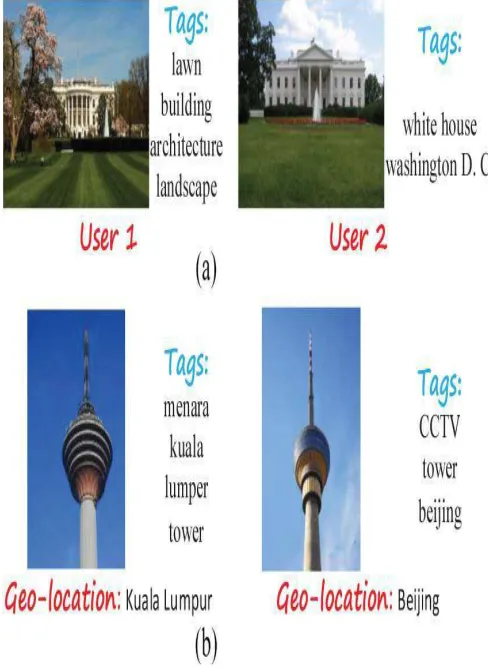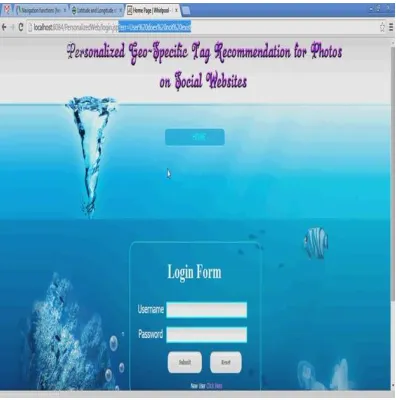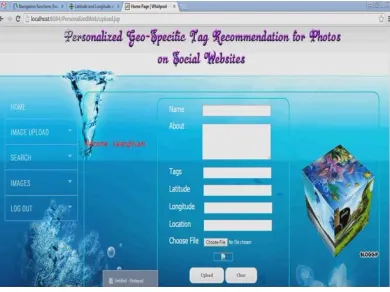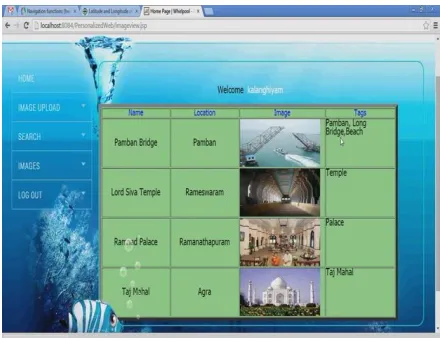ISSN(Online): 2320-9801 ISSN (Print): 2320-9798
I
nternational
J
ournal of
I
nnovative
R
esearch in
C
omputer
and
C
ommunication
E
ngineering
(An ISO 3297: 2007 Certified Organization)
Vol. 4, Issue 11, November 2016
Personalized Geo-Specific Tag
Recommendation for Photos on Social
Websites
Shinde Ganesh, Prof. Bere S.S
PG Scholar, Dept. of Information Technology, DGOIFOE, Bhigwan, Pune, India
Dept. of computer Engineering, DGOIFOE, Bhigwan, Pune, India
ABSTRACT: Now a day’s social tagging is an important in social websites to provide a good tagging for photos uploaded to the websites to access high quality social tags. Tag recommendation by automatically assigning related tags to photos to find out particular interesting area. In this paper we concentrate on the personalized recommendation work and try to choose user preferred geo-location specific as well as relevant tags for photos on social website. For users and geo-locations we assume they have various preferred tags assigned to a photo and purpose a subspace learning method to individually uncover the user preference and geo-location preference. The goal of our work is to combine a visual and textual space into a unified subspace. According to unified subspace is mapped from the intermediate subspace and textual subspace respectively. We create formula for above learning problems into united form and present the minimization with its convergence rule. For a given an untagged photo with its geo-location to a user we used the nearest neighbor search in the relating unified space. The user preferred and geo-location specified tags. Experiments on big scaled data sets collected from flicker examine the effectively of the proposed system.
KEYWORDS: Geo-location preference, User preference personalized recommendation, Subspace learning, Tagging history.
I. INTRODUCTION
Due to the increasingly popular of GPS-enable camera devices and mobile phones, now a day’s have witnessed potential growth of personal photos like tags, geo-location and visual attributes (colors and textures) [1]. In addition many photo sharing websites like Flicker, Corbis, Picasa and Zoomed access millions of users to upload and share their personal photos by their smart phones or other internet devices. A tag is a non-hierarchical term assigned to a data (such as an internet bookmark, digital image or computer file).Tagging allows user to find out related images when retrieving that image later. User can assign tags for photos but it is very time consuming. Tag recommendation specifies user to assign more tags in connecting gap between user concept and features of media images, which provide probable solution for CBIR (Content Based Information Retrieval). Many tag recommendation methods have worked upon connection between tags and photos [1].
II. RELATED WORK
M. Ames et.al proposed in [2], it covered How to motivate users to provide tags to images. They have entitled all features that are provided by Flickr to the users. Authors have proposed a Zone tag application that has interface to provide title, tag, and description to photo that is going to be uploaded. However following are drawbacks of that method, Tag Suggestion becomes ambiguous and non-obvious. Irrelevant tag recommendation is encountered in this method. User preference is not considered with respect to visual content he has previously published.
A. Sun et.al proposed in [3], Tag recommendation is three stage process a) Tag relationship graph construction. b) Concept detection. c) Actual Tag recommendation. It enabled customized matching score computation of each user. It enhances scalability and efficiency of tag recommendation process. However, Geo specific information is not considered here.
B. Sigurbjörnsson et.al proposed in [4], Input to this system was photo along with user defined tags. System generated ordered list of m-candidate tags based on tag co-occurrence. List of candidate tags are used as input for tag aggregation and ranking. It has produced ranked list of n-recommended tags. It can handle growth of tags vocabulary. It can be used to recommend photos based on locations, artifacts, and objects. However it limits tags that are going to be provided by user. It is not personalized approach. System being less interactive as well as performance calculation is not accurate. System requires vital tuning parameters to be managed and this makes system expensive.
ISSN(Online): 2320-9801 ISSN (Print): 2320-9798
I
nternational
J
ournal of
I
nnovative
R
esearch in
C
omputer
and
C
ommunication
E
ngineering
(An ISO 3297: 2007 Certified Organization)
Vol. 4, Issue 11, November 2016
A. Silva and B. Martins proposed in [5], Geo-referenced tag recommendation annotates geo referenced photos with descriptive tags. In this method supervised learning is used to rank methods by combining different estimators of tag relevance. Various ranking techniques are used. It does not consider content of image to improve to visual search as well as it ignores user preferences.
N.garg and I.Weber et al proposed in [6], A personalized tag recommendation idea that find out the tagging history by profile of users created by his sharing of photos and tags. System suggests tags dynamically based on it. It leads to conventional performance. It is less computationally complex than collective knowledge so that it can recommend tags dynamically. However, it ignores metadata of image and tags. Therefore, it leads to ignore preferences.
D. Rafailidis et al proposed in [7], a method that can handle very sparse data with Quadruple of user, image, tag and its associated weight. First, Construction of three order tensor then unfold matrix to create new three intermediate matrices. Use SVD on each unfolded matrix after that construction of core tensor s. Reconstruction of tensor then generation of item recommendation. It handles cold start and Sparsity problem. However it
ignored geo specific information and time space computations were too much. To tackle visual and textual tag recommendation along with geo tags.
Z. li et.al proposed in [8], subspace learning method in that unified latent space is find that combine visual, textual and Geo tagged relations.
Zhou et.al proposed in [9], hyper graph is nothing but a generalization of the simple graph in which the edges, called hyper edges, are non-empty subsets of the vertex set. Therefore, the hyper graph can be used to model entities and sparse relations.
Liu et.al proposed in [10], A transductive learning framework for image retrieval. It is based on a probabilistic Hyper graph. This method builds a Hyper graph by generating a hyper edge from each image and its adjacent neighbors after that ranking based on Hyper graph is then performed. Visual similarity matrix calculated from feature descriptors. Liu has chosen each image as a centroid vertex and created a hyper edge by a centroid and its k-nearest neighbors. It captured higher-order relationship.
Yue et.al proposed in [11], Intended an approach that simultaneously utilizes both visual and textual information for social image search.
In our proposed method, visual content and tags are used to generate the hyper edges of a Hyper graph. A relevance learning method is performed on the Hyper graph structure where a set of relevant samples are employed. Different from the conventional Hyper graph learning algorithms, our method learns not only the tag relevance based among images but also the Geo tags provided by that particular user. By using visual similarity edge and textual similarity edge we can recommend tags for that particular user.
III. IMPLEMENTATION DETAILS
System Architecture
Fig 2: System Architecture
It generates subspace that creates latent space that is output of visual space and textual space. It recommends tags based on this embedded space and it uses content based image retrieval techniques to find and retrieve similar types of images. Those Images are recommended to user. Tag recommendation uses similarity of visual and textual similarities. It recommends tags and photos to users based on his interest, profile history, image features and geo specific interest.
Modules:-
Data Collection:
In this first module, we collect the biggest amount of images with their tags, taggers, geo-locations and related text information with collected resources. We organize the photos with respect to different users and geo-locations separately. Our aim is to find a unified space for the visual and textual information is comparable i.e the relations between the both unrelated representations can be directly constructed in the data collection.
Tag Representation In Unified Space:
ISSN(Online): 2320-9801 ISSN (Print): 2320-9798
I
nternational
J
ournal of
I
nnovative
R
esearch in
C
omputer
and
C
ommunication
E
ngineering
(An ISO 3297: 2007 Certified Organization)
Vol. 4, Issue 11, November 2016
User Preference Learning:
In this module, we construct user preference learning module. Where taggers have personal preference for images which can be observed by the following two approaches. First, taggers favorite different types of images. Second, different taggers have different tags. In other words similar images would be tagged by two taggers in that different tags may be obtained.
Geo-Location Preference Learning:
In this fourth module, users are used to waste significant work to classify their photos albums geographically by illustrating photos with tags equivalent to position where they were taken accordingly geographical information of photos should be investigate the tag recommendation.
Advantage:
We integrate the above learning problems about the intermediate space and the unified space together into a
united formulation, and propose an effective optimization algorithm followed with its convergence proof.
We further combine the obtained tags and the visual appearance of the photo to discover the semantically and visually related images, and explore the idea of an-notation-by-search to rank tags for the untagged photo. Finally,
the top ranked tags are recommended to the user.
IV. RESULT ANALYSIS
Login Page
Registration Form
Fig 4: Registration Form
Upload Image
Fig 5: Upload Image
Upload Image with all Information
ISSN(Online): 2320-9801 ISSN (Print): 2320-9798
I
nternational
J
ournal of
I
nnovative
R
esearch in
C
omputer
and
C
ommunication
E
ngineering
(An ISO 3297: 2007 Certified Organization)
Vol. 4, Issue 11, November 2016
Image Details
Fig 4: Upload All Image details
V. CONCLUSION
In this work, we suggest to mine the personalized tag for newly updated photos using user profile based information such as their tagging histories, Geographic information, Geographic location information like the latitude and longitude values. we suggest new sub-space learning algorithm to independently find the user preference and Geo-location preference regarding tags. In the suggest method, the text features and visual features of photos are mapped into a unified space using transformation matrix.in this method 3 transformation matrix are used.one matrix is used for text features and remaining two matrices are used for visual features, to find the appropriate (relevant) tags of an untagg
REFERENCES
[1] B. Biggio, G. Fumera, , and F. Roli, “Security Evaluation of Pattern Classifiers under Attack” Ieee Transactions On Knowledge And Data Engineering, Vol. 26, No. 4, April 2014
[2] J. Liu, Z. Li, J. Tang, Y. Jiang, and H.Lu, “Personalized Geo-Specific Tag Recommendation for Photos on Social Websites,” IEEE Trans. Multimedia, vol. 16, no. 3, Apr. 2014
[3] T. L. Berg, A. C. Berg, and J. Shih, “Automatic attribute discovery and characterization from noisy web images,” in Proc. ECCV, 2010, pp. 663–676.
[4] Y. Shen and J. Fan, “Leveraging loosely-tagged images and inter-object correlations for tag recommendation,” in Proc. ACM Multimedia, 2010.
[5] J. Tang, S. Yan, R. Hong, G.-J. Qi, and T.-S. Chua, “Inferring semantic concepts from community-contributed images and noisy tags,” in Proc. ACM Multimedia, 2009.
[6] A. Sun, S. S. Bhowmick, and J.-A. Chong, “Social image tag recommendation by concept matching,” in Proc. ACM Multimedia, 2011. [7] H. Chen, M. Chang, P. Chang, M. Tien,W. Hsu, and J.Wu, “Sheepdog: Group and tag recommendation for flikr photos by automatic
searchbased learning,” in Proc. ACM Multimedia, 2008.
[8] Y. Song, L. Zhang, and C. L. Giles, “Automatic tag recommendation algorithms for social recommender systems,” ACM Trans. Web, vol. 5, no. 1, 2011
[9] B. Sigurbjörnsson and R. van Zwol, “Flickr tag recommendation based on collective knowledge,” in Proc. ACM WWW, 2008. [10] M. Ames and M. Naaman, “Why we tag: Motivations for annotation in mobile and online media,” in Proc. ACM CHI, 2007. [11] P. Serdyukov, V. Murdock, and R. van Zwol, “Placing Flickr photos on a map,” in Proc. ACM SIGIR, 2009.
[12] E. Moxley, J.Kleban, and B. S.Manjunath, “SpiritTagger:Ageo-aware tag suggestion tool mined from Flickr,” in Proc. ACM MIR, 2008. [13] J. Kleban, E. Moxley, J. Xu, and B. Manjunath, “Global annotation on georeferenced photographs,” in Proc. CIVR, 2009.




